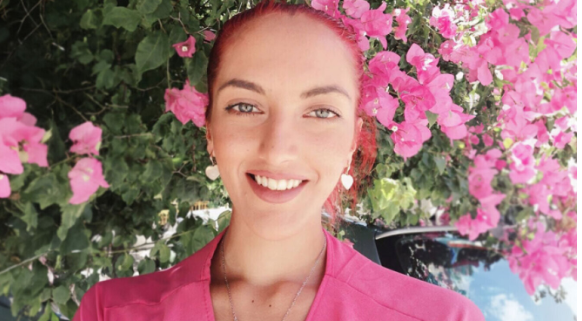In heterosexual men, pictures of rotting flesh, maggots and spoiled food induce the same physiological stress response as pictures of two men kissing each other. That is the surprising finding that was recently published in the peer-reviewed scientific journal Psychology & Sexuality.
“We originally were interested in understanding the health effects of same-sex vs. mixed-sex public displays of affection for the couples in the relationship,” explained the study’s corresponding author, Karen L. Blair of St. Francis Xavier University.
“However, one of the factors likely to influence how individuals experience PDAs is the reaction that other people have to witnessing PDAs. Consequently, we decided to begin the research by examining whether or not heterosexuals have negative responses to witnessing same-sex PDAs; in particular, we began by examining heterosexual male responses to male same-sex public displays of affection.”
“Participants watched a series of slideshows: male couples kissing, male couples holding hands, mixed-sex couples kissing, mixed-sex couples holding hands, boring images (e.g., paper clips) and disgusting images (maggots),” Blair explained. “In between slide shows, we asked participants questions about their responses to the photos (not yet published) and we also collected saliva samples in order to assess salivary alpha-amylase in response to each slide show (the current paper).”
Measuring levels of salivary alpha-amylase, a digestive enzyme that is associated with stress and is especially responsive to disgust, allowed the researchers to examine the men’s physiological reaction to the photos. The study was based on results from 120 heterosexual men (aged 18 to 45).
“In comparing the salivary alpha-amylase responses of participants to the various slideshows, we found that participants had higher salivary alpha-amylase responses to the images of two men kissing and the disgusting images. In both cases, these responses were significantly different than the responses they had to the neutral stimuli.”
However, Blair warned it was difficult to interpret the finding at this stage.
“It is difficult to specifically state what this means. It could mean that participants found the images of male same-sex couples kissing to be equally disgusting as the disgusting images. It could mean that they had an anxiety response to the male couples kissing and a disgust response to the disgusting images, but that physiologically, we could not tell the difference between these two emotions.”
Previous research has found a strong link between sexual prejudice and the emotion of disgust. For instance, a 2008 study found that individuals who are more easily disgusted are also more likely to make unfavorable moral judgments about gay people.
But it was clear that the physiological reactions in the present study could not be explained by the participants’ sexual prejudices alone.
“What is most important to note is that the responses did not differ as a function of self-reported levels of prejudice or self-reported levels of aggression towards gay men,” Blair explained. “In other words, it was not our highly prejudiced individuals who were experiencing a heightened physiological response to the images of same-sex couples kissing, it was everyone in the sample, even those with very low levels of prejudice.”
The finding provides more evidence that the so-called “gay panic” defense — the assertion that a person’s sexual orientation can “trigger” a crime against them — is bunk. The defense was used by the two men who beat, tortured and murdered gay student Matthew Shepard in 1998.
“Whatever is happening physiologically when someone witnesses same-sex PDA, it is not something so strong, or so uncontrollable as to explain the patterns of violent LGBTQ-hate crimes that have been repeatedly reported in the media,” Blair told PsyPost. “Clearly, the large majority of individuals who witness same-sex PDAs do not respond with violence, indicating that whatever small physiological response we are noticing here is not evidence for an uncontrollable or overwhelming fit of panic, as suggested by the ‘gay panic’ defense.”
“Why do people low in prejudice still show an increased physiological response? We can’t say definitively, however, it could be that society has socialized the notion of same-sex sexuality and affection as being ‘disgusting’ or immoral so strongly, for so long, that merely witnessing it causes a slight physiological stress response. It would be interesting for future research to examine whether this physiological effect is more likely to be found in cultures that still evidence high levels of prejudice compared to those who have made more progress towards normalizing same-sex affection and sexuality.”
The study is the first of its kind, and the researchers hope that future research will strengthen their findings. There are also some questions that additional research could help answer.
“This is a very preliminary investigation of the physiology of sexual prejudice,” Blair said. “The work needs to be replicated with a larger sample and with more indicators of physiological reactivity as well as additional indicators to help decipher what the physiological responses mean. For example, it is difficult to determine whether an elevated salivary alpha-amylase level indicates stress, fear, or anger.”
“One thing that we will be looking at in our own data to help solve this mystery is emotion-coding of the facial expressions participants made while watching each of the slide shows. This may help us to understand what emotions were prominent, especially among those self-reporting higher levels of sexual prejudice. We also need to replicate with different participants (men and women, in different locations) looking at different targets (e.g., female same-sex couples, gender-diverse couples, interracial couples, etc.). Each iteration of the study is quite expensive though, due to the collection of physiological data, so it will take some time and additional funding before we can run each of the iterations that we would like to run.”
“This research was largely funded through a crowdfunding campaign on Experiment.com (http://www.drkarenblair.com/pdasponsors/), and later by the American Institute of Bisexuality. More information on how we fund some of our LGBTQ-related research can be found here: https://www.patreon.com/KLBResearch.”
The study, “What do two men kissing and a bucket of maggots have in common? Heterosexual men’s indistinguishable salivary α-amylase responses to photos of two men kissing and disgusting images“, was also co-authored by Breanna Maureen and Rhea Ashley Hoskin.

































